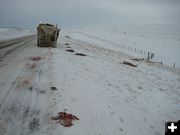

Winter, Speed Kills
Scenes like this one, when on Nov. 23, 2010, on US 189 south of Kemmerer, where 54 antelope were killed by a semi truck driving too fast for conditions, are becoming more common. The Wyoming Game and Fish attributes these situations to winter conditions and vehicle speeds in areas that have always been considered crucial winter range.
|
|
Winter driving requires extra caution around wildlife
by Wyoming Department of Transportation
March 4, 2011
Collisions with wildlife in Wyoming is on an increase, although the actual numbers are uncertain, since many of these collisions go unreported. During the five-year period that ended in 2010, reported collisions with wildlife has increased by more than 17 percent from the previous five-year period.
During this period, 11 people were killed and more than 500 were injured with more than 10,000 vehicles damaged in Wyoming due to motor vehicle/wildlife animal collisions. Most of these collisions with wildlife could have been avoided.
Although death and injury is always a possibility in a wildlife collision, most commonly, the outcome of these collisions is damage to your vehicle. "Sadly, no matter how severe or minor the crash, a collision with wildlife will almost certainly kill the animal. If nothing else, actively trying to avoid such crashes will save animal lives and your vehicle," said Theresa Herbin, District 3 Public Relations Specialist in Rock Springs.
Wildlife is abundant in Wyoming and although collisions with big game can happen at any time of day or any time of year, the five-year totals show that these collisions commonly occur at dawn and dusk (1,428 between 5-7 a.m. and 5,745 between 5-10 p.m.) and were higher during the wildlife migration periods in June, July, October and November.
The Wyoming Department of Transportation has partnered with the Wyoming Game and Fish Department on several projects to reduce the number of wildlife collisions in the state. Together, they have:
Increased the numbers of warning signs along roads in wildlife migration areas,
Installed fencing to exclude wildlife from highways and right-of-way within heavy migration areas,
Installed flashing warning signs to use during migration periods,
Installed underpasses to provide safe wildlife crossings,
Removed heavy brush along the roadsides to provide better visibility for motorists.
Drivers in Wyoming can do many things to help reduce their risk of collision with wildlife:
Prepare:
If possible, avoid driving during dusk or dawn when most wildlife collisions occur,
Make sure headlights and windshield are clear of ice, snow, or dirt.
Herbin said, "Always wear your seat belt. Its your best defense against crash-related injuries or death. Buckle up, be alert, every time."
Be Alert:
Watch for the yellow wildlife warning signs that indicate areas of increased risk. Be alert when traveling through these areas, as they are migration routes,
Slow down while driving in these areas. By slowing down just five miles per hour, it will give them the ability to stop within the distance illuminated by their headlights and greatly increase their reaction time to avoid a collision,
Be extra alert and watch for wildlife in or along the highway during the early morning, at dusk and at night. These are the prime times when animals are most likely to be on the road and lighting is at the lowest in which to see them,
Scan the road ahead from shoulder to shoulder to look for movement. Animals usually travel in groups; if you see one, others probably are nearby,
When you see wildlife beside the road, slow down and pass carefully, because they could suddenly bolt onto the road,
Use high beam headlights at night where possible, and watch for the glowing eyes of animals. The high beams will better illuminate the eyes of animals on or near the road.
Another good way of preventing collisions with animals is to avoid distractions. A few distractions can include talking on a cell phone, fumbling with the vehicles audio system, or even eating while on the road. "These types of distractions can keep drivers' eyes off the road which in turn could lead to crashes. The less the distracted, the more likely drivers will be to know what is on the road ahead," she said
|
